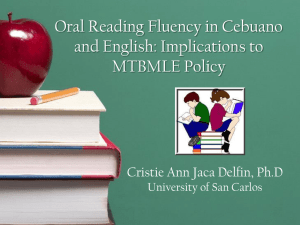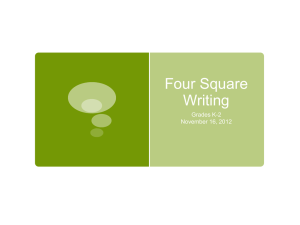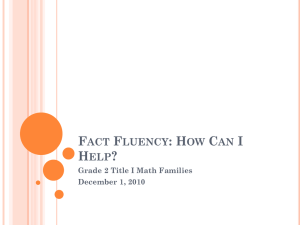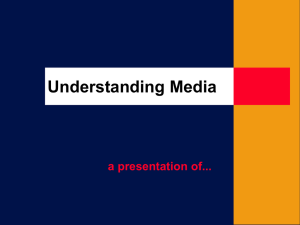Powerpoint File - Longwood University
advertisement
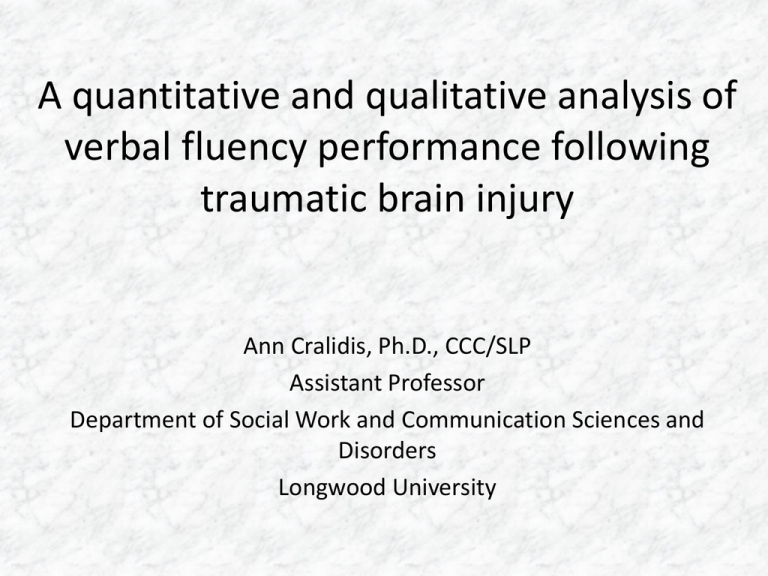
A quantitative and qualitative analysis of verbal fluency performance following traumatic brain injury Ann Cralidis, Ph.D., CCC/SLP Assistant Professor Department of Social Work and Communication Sciences and Disorders Longwood University INTRODUCTION Traumatic Brain Injury (TBI) Traumatic brain injury (TBI) is a disorder of major public health concern secondary to its high prevalence and proclivity for lifelong disability, as well as the deleterious impact it may have upon the resumption of daily living activities, including educational and vocational pursuits. An estimated 1.7 million traumatic brain injuries occur annually in the United States, of which 1.4 million seek medical attention at an emergency department. Cicerone et al., 2004; Faul et al., 2010; Langlois et al., 2006; McNett, 2007; Rutland-Brown et al., 2006; Selassie et al., 2008 Traumatic Brain Injury (TBI) Within this population, males are 1.4 times more likely than females to incur TBI. Furthermore, males between 25 and 44 years of age and who are in the most productive years of their lives account for approximately 36 percent of TBIs that result in hospitalization, with motor vehicle accidents cited as the primary cause of injury. Faul et al., 2010 Traumatic Brain Injury (TBI) Moreover, TBI is a costly public health concern, with an estimated 76.5 billion spent annually in the United States for the direct and indirect costs associated with medical care and loss of productivity. TBI is commonly denoted as a silent epidemic as the cognitivelinguistic impairments are often invisible, and as such, the general public is largely unaware of its existence. Coronado et al., 2012; Finkelstein et al., 2006; Langlois et al., 2006; Rutland-Brown et al., 2006 Traumatic Brain Injury (TBI) Within this context, a significant number of individuals with TBI often report some degree of cognitive-linguistic impairment, particularly in the areas of attention, memory, and executive function. One cognitive-linguistic function that appears vulnerable to the effects of TBI is verbal fluency. Capitani et al., 2009; Finkelstein et al., 2006; Levin et al., 1982; Raskin & Rearick, 1996; Ruff et al., 1986; Selassie et al., 2008 Verbal Fluency Phonemic Verbal Fluency Semantic Verbal Fluency Requires the generation of words that begin with a specific letter of the alphabet, such as F, A, or S. Participants are given 60 seconds to generate as many words as possible for each of the letters. Requires the generation of words that belong to a specific category, such as animals or boys’ names. Participants are given 60 seconds to generate as many words as possible for each category. Benton, 1968; Borkowski et al., 1967; Newcombe, 1969 Theories of Verbal Fluency Performance Spreading Activation Account Two-Stage Search Process May account for the manner in which words are organized. One word may prime a network of highly related words. The word dog may prime the retrieval of other pets, and words that share similar features with dog, such as wolf and coyote. A cyclical process of search and retrieval wherein individuals first search for a relevant subcategory, then retrieve words from the subcategory. A new search is initiated once the subcategory is exhausted. Anderson & Pirolli , 1984; Collins & Loftus, 1975 Gruenewald & Lockhead, 1980 Neural Correlates of Verbal Fluency Frontal Cortices Temporal Lobes Mediate phonemic verbal fluency performance via the use of phonemic or lexical cues. Performance on phonemic verbal fluency tasks, compared to semantic verbal fluency, is diminished in those with frontal lobe dysfunction. Mediate semantic verbal fluency performance via the use of semantic knowledge. Performance on semantic verbal fluency tasks, compared to phonemic verbal fluency, is diminished in those with temporal lobe dysfunction. Birn et al., 2010; Ho et al., 2002; Troyer, 2000; Troyer et al., 1998a Birn et al., 2010; Troyer et al., 1998a, 1998b Verbal Fluency Following TBI Verbal fluency performance has been extensively investigated in participants with diffuse cerebral damage, such as with TBI. The results of some of these studies have indicated that both phonemic and semantic verbal fluency are equally disturbed following TBI. To illustrate, Raskin and colleague (1996) found that participants with mild TBI were significantly different from those with no brain damage (NBD) relative to the total number of words generated on both types of verbal fluency tasks. Bittner & Crowe, 2006, 2007; Capitani et al., 2009; Goldstein et al., 1996; Gruen et al., 1990; Jurado et al., 2000; Kavé et al., 2011; Raskin & Rearick, 1996; Ruff et al., 1986; Zakzanis et al., 2011 Verbal Fluency Following TBI Some investigations have found greater impairment in phonemic verbal fluency performance, when compared to semantic verbal fluency performance, in individuals with TBI. To date, only one study has found that individuals with TBI are differentially impaired on semantic verbal fluency, in comparison to performance on phonemic verbal fluency, when compared to participants with NBD. Capitani et al., 2009; Goldstein et al., 1996; Levin & Goldstein, 1986 Verbal Fluency and TBI While disturbances in verbal fluency may be most apparent immediately following injury, there is emerging evidence that these difficulties may persist for many years following injury, particularly in individuals with moderate to severe TBI (MOD/S TBI) Henry & Crawford, 2004; Kinnunen et al., 2010; Kraus et al., 2007; Ruff et al., 1986; Whitnall et al., 2006 The Relevance of Verbal Fluency to Everyday Living Verbal fluency performance, as indicated by the total number of words produced, has been associated with greater independence in completing functional activities. Fortin and colleagues (2003) noted a significant association between the number of errors made on a meal preparation task and performance on a semantic verbal fluency task in participants with mild to severe TBI, when compared to a group of participants with no brain damage (NBD). The Relevance of Verbal Fluency to Everyday Living More recently, Chevignard and colleagues (2008) investigated the relationship between meal preparation and phonemic and semantic verbal fluency performance in participants with severe TBI and a group of participants with NBD. They found that the TBI group produced a significantly greater number of errors (i.e., omissions, additions) during the cooking task when compared to the NBD group. The Relevance of Verbal Fluency to Everyday Living Moreover, participants with TBI were significantly less likely to complete the task within the allotted time frame and to finish preparing both an entrée and dessert in comparison to the NBD group. Chevignard et al., 2008 THE PRESENT INVESTIGATION Primary Objective The present investigation sought to determine whether participants with moderate to severe traumatic brain injury (MOD/S TBI) would differ both quantitatively and qualitatively from participants with no brain damage (NBD). METHODS Participants Moderate to Severe TBI (MOD/S TBI): n = 25 No Brain Damage (NBD): n = 25 12 Females, 38 Males All participants were paired so that they did not significantly differ relative to age, education, or gender. Test Measures Verbal Fluency Subtest from the Delis-Kaplan Executive Function System (D-KEFS: Delis et al., 2001) to assess phonemic and semantic verbal fluency. Analyzing Verbal Fluency Performance Quantitative The most common measure employed. Defined as the total number of words generated within 60seconds on each type of fluency task. Qualitative Types of words produced Clustering of semantic features How frequently subcategories are exhausted and switched in favor of a new subcategory. Raskin et al., 1992; Troyer, 2000; Troyer et al., 1997 An Example of Qualitative Analyses Phonemic Verbal Fluency First Letters: Stun, Stick First/Last Sounds: Seat, Set Homonyms: Sum, Some Rhymes: Sand, Stand Semantic Verbal Fluency African Animals: Lion Tiger Elephant Giraffe Ostrich Troyer, 2000; Troyer et al., 1997 RESULTS QUANTITATIVE RESULTS Phonemic Verbal Fluency MOD/S TBI: Generated significantly fewer total correct words (M = 29.80, SD = 12.89) than NBD (M = 38.88, SD = 13.16; t(48) = -2.46, p = .017). Semantic Verbal Fluency MOD/S TBI: Generated significantly fewer total correct words (M = 33.79, SD = 10.40) for both semantic categories than NBD (M = 45.60, SD = 9.56; t(48) = -4.19, p = .001). QUALITATIVE RESULTS: NUMBER OF SWITCHES SWITCHING PHONEMIC VERBAL FLUENCY MOD/S TBI: Produced significantly fewer switches on the letter S (M = 8.44, SD = 3.43) than did NBD (M = 10.32, SD = 3.73; t(48) = -1.86, p = .034). No significant differences between the groups for the letters F and A. SEMANTIC VERBAL FLUENCY MOD/S TBI: Produced significantly fewer switches for the semantic category of animals (M = 8.20, SD = 3.16) than did NBD (M = 10.48, SD = 4.13; t(48) = -2.19, p = .017) QUALITATIVE RESULTS: MEAN CLUSTER SIZE MEAN CLUSTER SIZE PHONEMIC VERBAL FLUENCY MOD/S TBI: Produced significantly smaller mean cluster sizes only for the letter A (M = .22, SD = .21) compared to NBD (M = .48, SD = .44, t(48) = -2.69, p = .005). No significant group differences for the letters F or S. SEMANTIC VERBAL FLUENCY MOD/S TBI: No significant group differences for the semantic category of animals. PEARSON CORRELATIONS BETWEEN VERBAL FLUENCY, NUMBER OF SWITCHES, AND MEAN CLUSTER SIZE QUALITATIVE RESULTS: NUMBER OF SUBCATEGORIES SUBCATEGORIES PHONEMIC VERBAL FLUENCY MOD/S TBI: Generated significantly fewer total subcategories (M = 1.96; SD = 1.02) compared to NBD (M = 2.52, SD = .96; t(48) = -2.00, p = .026). SEMANTIC VERBAL FLUENCY MOD/S TBI: Generated significantly fewer total subcategories (M = 5.44, SD = 1.94) for animals, compared to NBD (M = 6.56, SD = 2.18; t(48) = 1.92, p = .030). Troyer et al. 1997 QUALITATIVE RESULTS: TYPES OF SUBCATEGORIES SUBCATEGORIES PHONEMIC VERBAL FLUENCY Participants, regardless of group, generated words using the characteristics first letters, followed by first and last sounds. SEMANTIC VERBAL FLUENCY Both groups generated the greatest number of words by drawing from the major category of Living Environment, and then, from the subcategory of African animals. Troyer et al., 1997 QUALITATIVE THE MODIFIED VERSION FOR ANALYZING SUBCATEGORIES IN VERBAL FLUENCY Troyer et al., 1997 Previously, Cralidis and Lundgren (2009) explored the types of subcategories produced by a group of participants with MOD/S TBI. We found that the types of subcategories differed from those originally identified by Troyer and colleagues (1997). QUALITATIVE THE MODIFIED VERSION FOR ANALYZING SUBCATEGORIES IN VERBAL FLUENCY Troyer et al., 1997 When we applied the modified version for analyzing subcategories to the present investigation, we found that the majority of subcategories we identified failed to describe a sufficient number of the subcategories given by all participants for both tasks of verbal fluency. DISCUSSION PHONEMIC & SEMANTIC VERBAL FLUENCY As predicted, the MOD/S TBI group performed more poorly than the NBD group on both verbal fluency tasks, as indicated by the total number of words generated, a finding that is supported by previous research. The MOD/S TBI group was disproportionately impaired on the phonemic verbal fluency task, when compared to the semantic verbal fluency task. Some studies have observed greater impairment in phonemic verbal fluency, when compared to semantic verbal fluency, in participants with TBI, although support is not unequivocal. Capitani et al., 2009; Jurado et al., 2000; Kavé et al., 2011; Levin & Goldstein, 1986 CLUSTERING Troyer et al. (1997) have posited that participants with pervasive brain damage, as is often observed in TBI, may be equally impaired on clustering and switching in verbal fluency tasks, although one tends to predominate. The present investigation confirmed this notion by the observed absence of a correlation between clustering on the letters F and S, the category of animals, and the total number of words produced on both verbal fluency tasks. The findings suggest a deficit in the ability to effectively cluster words, as words are thought to form a structured semantic network that when primed, may further activate a number of related words. Anderson & Pirolli, 1984; Collins & Loftus, 1975 SWITCHING The findings in the present investigation suggest that the ability to generate a large number of words on both verbal fluency tasks is associated with a greater number of switches on both fluency tasks. In contrast, Troyer et al. (1997) observed a significant relationship only between the number of switches made and the total number of words produced on a task of phonemic verbal fluency in an NBD group. The results of the present investigation suggest that participants exhibited greater difficulty in the ability to cluster, when compared to the ability to switch, on both tasks of verbal fluency. SUBCATEGORIES The MOD/S TBI group produced significantly fewer total subcategories on both verbal fluency tasks when compared to the NBD group. When the scoring method of Troyer et al. (1997) was applied, both groups drew primarily from the major category of Living Environment, and from the subcategory of African Animals, when generating words for the semantic category of animals. On the phonemic verbal fluency task, both groups generated subcategories by primarily grouping words by First Letters, in accordance with the scoring method set forth by Troyer et al. (1997). LIMITATIONS Limited ability to generalize the results to the TBI population at large. Small sample sizes. Etiological variation of the MOD/S TBI group. CONCLUSION The MOD/S TBI group generated significantly fewer total words on both verbal fluency tasks when compared to the NBD group. The MOD/S TBI group was impaired relative to the NBD group in the ability to cluster and switch, and to generate subcategories, on both verbal fluency tasks, a finding that may have contributed to the reduction in the total number of words generated on these tasks. FUTURE DIRECTIONS Develop and pilot a comprehensive protocol to measure strategy use on tasks of verbal fluency. Explore the relevance of working memory, information processing speed, and other executive functions for their potential contribution to efficacious performance on tasks of verbal fluency. Investigate the relationship between verbal fluency performance and completion of a functional activity in a population with MOD/S TBI. Develop and pilot a training program for survivors of TBI who exhibit verbal fluency deficits. REFERENCES Anderson, J. R., & Pirolli, P. L. (1984). Spread of activation. Journal of Experimental Psychology: Learning, Memory, and Cognition, 10, 791 – 798. doi:10.1037/0278-7393.10.4.791 Benton, A. L. (1968). Differential behavioral effects in frontal lobe disease. Neuropsychologia, 6, 53–60. doi: 10.1016/0028-3932(68)90038-9 Birn, R. M., Kenworthy, L., Case, L., Carvella, R., Jones, T. B., Bandettini, P. A., & Martin, A. (2010). Neural systems supporting lexical search guided by letter and semantic category cues: A self-paced overt response fMRI study of verbal fluency. Neuroimage, 49, 1099–1107. doi:10.1016/j.neuroimage.2009.07.036 Bittner, R. M., & Crowe, S. F. (2006). The relationship between naming difficulty and FAS performance following traumatic brain injury. Brain Injury, 20, 971–980. doi: 10.1080/02699050600909763 Bittner, R. M., & Crowe, S. F. (2007). The relationship between working memory, processing speed, verbal comprehension, and FAS performance following traumatic brain injury. Brain Injury, 21, 709–719. doi:10.1080/02699050701468917 Borkowski, J. G., Benton, A. L., & Spreen, O. (1967). Word fluency and brain damage. Neuropsychologia, 5, 135–140. doi:10.1016/0028-3932(67)90015-2 Capitani, E., Rosci, C., Saetti, M. C., & Laiacona, M. (2008). Mirror asymmetry of category and letter fluency in traumatic brain injury and Alzheimer’s patients. Neuropsychologia, 47, 423–429. doi:10.1016/j.neuropsychologia.2008.09.016 Chevignard, M. P., Taillefer, C., Picq, C., Poncet, F., Noulhiane, M., & Pradat-Diehl, P. (2008). Ecological assessment of the dysexecutive syndrome using execution of a cooking task. Neuropsychological Rehabilitation, 18, 461 – 485. doi:10.1080/09602010701643472 Cicerone, K. D., Mott, T., Azulay, J., & Friel, J. C. (2004). Community integration and satisfaction with functioning after intensive cognitive rehabilitation for traumatic brain injury. Archives of Physical Medicine and Rehabilitation, 85, 943–950. doi:10.1016/j.apmr.2003.07.019 Collins, A. M., & Loftus, E. F. (1975). A spreading-activation theory of semantic processing. Psychological Review, 82, 407–428. doi:10.1037/0033-295X.82.6.407 Coronado, V. G., Faul, M., Sugerman, D., McGuire, L. C., & Pearson, M. L. (in press). The epidemiology and prevention of TBI. Retrieved from http://www.cdd.gov/ TraumaticBrainInjury/statistics.html Cralidis, A., & Lundgren, K. (2009). Verbal fluency patterns in individuals with traumatic brain injury. Journal of the International Neuropsychological Society, 15(Suppl. 1), 69. doi:10.1017/S1355617709090420 Delis, D. C., Kaplan, E., & Kramer, J. H. (2001). Delis-Kaplan Executive Function System. San Antonio, TX: The Psychological Corporation. Faul, M., Xu, L., Wald, M. M., & Coronado, V. G. (2010). Traumatic brain injury in the United States: emergency department visits, hospitalizations, and deaths. Atlanta, GA: Centers for Disease Control and Prevention, National Center for Injury Prevention and Control. Retrieved from http:// www.cdc.gov/traumaticbraininjury/pdf/blue_book.pdf Finkelstein, E., Corso, P., & Miller, T. (2006). The incidence and economic burden of injuries in the United States. New York: Oxford University Press. Fortin, S., Godbout, L., & Braun, C. M. J. (2003). Cognitive structure of executive deficits in frontally lesioned head trauma patients performing activities of daily living. Cortex, 39, 273 – 291. doi:10.1016/50010-9452(08)70109-6 Goldstein, F. C., Levin, H. S., Roberts, V. J., Goldman, W. P., Kalechstein, A. S., Winslow, M., & Goldstein, S. J. (1996). Neuropsychological effects of closed head injury in older adults: A comparison with Alzheimer’s disease. Neuropsychology, 10, 147–154. doi: 10.1037/08944105.10.2.147 Gruen, A. K., Frankle, B. C., & Schwartz, R. (1990). Word fluency generation skills of head-injured patients in an acute trauma center. Journal of Communication Disorders, 23, 163–170. doi:10.1016/0021-9924(90)90020-Y Gruenewald, P. J., & Lockhead, G. R. (1980). The free recall of category examples. Journal of Experimental Psychology: Human Learning and Memory, 6, 225–239. doi: 10.1037/0278-7393.6.3.225 Henry, J. D., & Crawford, J. R. (2004). A meta-analytic review of verbal fluency performance in patients with traumatic brain injury. Neuropsychology, 18, 621–628. doi: 10.1037/08944105.18.4.621; 10.1037/0894-4105.18.4.621 Jurado, M. A., Mataro, M., Verger, K., Bartumeus, F., & Junque, C. (2000). Phonemic and semantic fluencies in traumatic brain injury patients with focal frontal lesions. Brain Injury, 14, 789– 795. doi:10.1080/026990500421903 Kavé, G., Heled, E., Vakil, E., & Agranov, E. (2011). Which verbal fluency measure is most useful in demonstrating executive deficits after traumatic brain injury? Journal of Clinical and Experimental Neuropsychology, 33, 358–365. doi: 10.1080/13803395.2010.51870 Kinnunen, K. M., Greenwood, R., Powell, J. H., Leech, R., Hawkins, P. C., Bonnelle, V., . . . Sharp, D. J. (2010). White matter damage and cognitive impairment after traumatic brain injury. Brain. Advance online publication. doi:10.1093/ brain/awq347 Kraus, M. F., Susmaras, T., Caughlin, B. P., Walker, C. J., Sweeney, J. A., & Little, D. M. (2007). White matter integrity and cognition in chronic traumatic brain injury: A diffusion tensor imaging study. Brain, 130, 2508– 2519. doi:10.1093/brain/ awm216 Langlois, J. A., Rutland-Brown, W., & Thomas, K. E. (2006). Traumatic brain injury in the United States: Emergency department visits, hospitalizations, and deaths. Atlanta, GA: Centers for Disease Control and Prevention, national Center for Injury Prevention and Control. Retrieved from http:// www.cdc.gov/ncipc/pub-res/TBI_in_US_04/TBI%20in%20the %20US_Jan_2006.pdf Levin, H. S., Benton, A. L., & Grossman, R. G. (1982). Neurobehavioral consequences of closed head injury. New York: Oxford University Press. Levin, H. S., & Goldstein, F. C. (1986). Organization of verbal memory after severe closed-head injury. Journal of Clinical and Experimental Neuropsychology, 8, 643–656. doi: 10.1080/01688638608405185 McNett, M. (2007). A review of the predictive ability of the Glasgow Coma Scale scores in head-injured patients. Journal of Neuroscience Nursing, 39, 68– 75. Retrieved from http://www.aann.org/journal/content/index.html Newcombe, F. (1969). Missile wounds of the brain. London, UK: Oxford University Press. Raskin, S. A., & Rearick, E. (1996). Verbal fluency in individuals with mild traumatic brain injury. Neuropsychology, 10, 416– 422. doi:10.1037/0894-4105.10.3.416 Ruff, R. M., Evans, R., & Marshall, L. F. (1986). Impaired verbal and figural fluency after head injury. Archives of Clinical Neuropsychology, 1, 87–101. doi: 10.1016/08876177(86)90009-0 Rutland-Brown, W., Langlois, J. A., Thomas, K. E., & Xi, Y. L. (2006). Incidence of traumatic brain injury in the United States, 2003. Journal of Head Trauma Rehabilitation, 21, 544–548. Retrieved from http://journals.lww.com/headtraumarehab/pages/ Selassie, A. W., Zaloshnja, E., Langlois, J. A., Miller, T., Jones, P., & Steiner, C. (2008). Incidence of long-term disability following traumatic brain injury hospitalization, United States, 2003. Journal of Head Trauma Rehabilitation, 23, 123 – 131. doi: 10.1097/01.HTR.0000314531.30401.39 Troyer, A. K. (2000). Normative data for clustering and switching on verbal fluency tasks. Journal of Clinical and Experimental Neuropsychology, 22, 370–378. doi: 10.1076/13803395(200006)22:3;1-V;FT370 Troyer, A. K., Moscovitch, M., & Winocur, G. (1997). Clustering and switching as two components of verbal fluency: Evidence from younger and older healthy adults. Neuropsychology, 14, 138–146. doi: 10.1037/089404105.11.1.138 Troyer, A. K., Moscovitch, M., Winocur, G., Alexander, M. P., & Stuss, D. (1998). Clustering and switching on verbal fluency: The effects of focal frontal- and temporal-lobe lesions. Neuropsychologia, 36, 499–504. doi:10.1016/S0028-3932(97)00152-8 Troyer, A. K., Moscovitch, M., Winocur, G., Leach, L., & Freedman, M. (1998). Clustering and switching on verbal fluency tests in Alzheimer’s and Parkinson’s disease. Journal of the International Neuropsychological Society, 4, 137–143. Retrieved from http://journals.cambridge.org/ action/displayJournal?jid=INS Whitnall, L., McMillan, T. M., Murray, G. D., & Teasdale, G. M. (2006). Disability in young people and adults after head injury: 5-7 year follow up of a prospective cohort study. Journal of Neurology, Neurosurgery, and Psychiatry, 77, 640– 645. doi:10.1136/jnnp.2005.078246 Zakzanis, K. K., McDonald, K., & Troyer, A. K. (2011). Component analysis of verbal fluency in patients with mild traumatic brain injury. Journal of Clinical and Experimental Neuropsychology, 33, 785–792. doi: 10.1080/13803395.2011.558496



